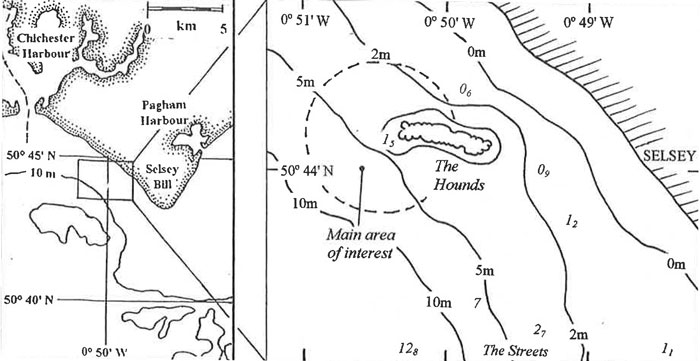SUSSEX MARINE SITES OF NATURE CONSERVATION IMPORTANCE
| Site: The Hounds | Ref. No. 13 | ||||||
| Location: Bracklesham Bay. 3 km NW of Selsey Bill. | Other conservation designation?: No |
||||||
| Lat./Long. position of centre of site: 50° 44' 16" N 0° 50' 52" W |
OS grid ref. of centre of site: SZ 817 936 |
Author: Robert Irving |
|||||
| Sea bed type: Limestone outcrops of bedrock and boulders, with some horizontal clay exposures and mixed substrata. |
Depth range (below chart datum): 0-8 m |
Date identified: June 2001 |
|||||
Summary
The Hounds reef lies close inshore at the south-eastern edge of Bracklesham Bay. The shallowest parts of the reef are exposed at low water springs. It would appear as though the reef is formed of limestone cap-rock, either intact in the form of bedrock or as broken flat slabs. Underlying this limestone stratum, which is only 15-20 cm deep, is a softer clay layer which has been eroded in places, forming holes and caves beneath the limestone. In amongst the rocky outcrops are small open areas with a mix of small boulders, cobbles and pebbles overlying horizontal clay. The primary interest of the site lies within a radius of 250 m from the centre of the site.
Biological Description
Upward-facing surfaces of the bedrock outcrops are sparsely colonised by an assortment of algal species including Laminaria kelp plants (rare-occasional) and the red foliose algae Calliblepharis ciliata and Halurus flosculosus (both frequent). These surfaces, however, are often heavily silted, local erosion of the clay leading to a frequently high loading of fine material in the water column, especially after rough weather. Where algae are less dominant, various sessile faunal species may be found including occasional white anemones Actinothoe sphyrodeta, dead man's fingers Alcyonium digitatum and small patches of the grey colonial ascidian Diplosoma listerianum. Encrusting sponges include the 'shredded carrot' sponge Esperiopsis fucorum, the 'goose bump' sponge Dysidea fragilis, Hymeniacedon perleve and Halichondria bowerbanki. More upright species include the hydroid Hydrallmania falcata and hornwrack Flustra foliacea.
Exposures of clay/mudstone are often scoured clean of attached life (by other mobile sediments), though they are frequently riddled with piddock holes (probably both Pholas dactylus and Hiatella arctica being present). Patches of sand are largely bare of surface dwelling species (epifauna), with the exception of occasional sandmason worms Lanice conchilega and netted dogwhelks Hinia reticulata.
Surrounding seabed areas of mixed sediments (mostly of pebbles, gravel, sand and slipper limpet shells) have few attached species associated with them, with the exception of live slipper limpet chains Crepidula fornicata and occasional oysters Ostrea edulis. Mobile species include various crustaceans (particularly crabs, hermit crabs and prawns), small gobies and dragonets Callionymus lyra.
Justification
Sublittoral rocky reefs account for probably less than 3% of the total area of seabed off Sussex (within the 12 nm limit of territorial waters). Exposed sublittoral limestone strata are rarely encountered off Sussex, most of the reefs being formed of sandstone or chalk. Other occurrences of limestone cap-rock are found at the Outer Owers (to the SE of Selsey Bill - mSNCI ref no. 15) and on scattered, isolated 'mushroom-like' formations in Bracklesham Bay.
References:Irving, R. A. 1998. Sussex Marine Life - an identification guide for divers East Sussex Council, Lewes |
|||||||
| Sussex SEASEARCH dive nos.: 711/32, 33, 35, 713/159 & 717/22 | |||||||
Site Location

Diagrammatic representation of site: The Hounds


:Link to this page
Copyright Sussex Biodiversity Records Centre © 2025